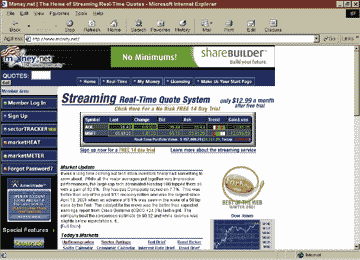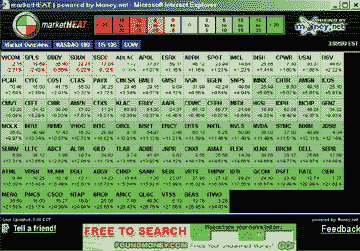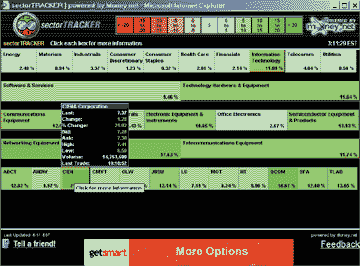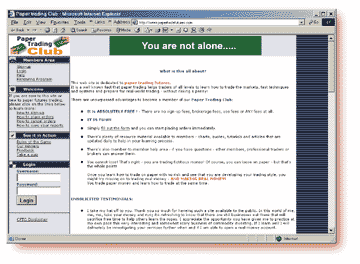![]()
WWW.MONEY.NET
WWW.MONEY.NET
When you come across a site that is well designed, bright, and colorful, it's hard to pass by without a closer look. That is what led me to Money.net (Figure 1), the financial portal through which you can access enough information on the stock market to consider placing a trade. The homepage contains significant news stories that are updated each trading day. These can be accessed at no cost, but the site's worthwhile features are accessible for a monthly fee of $9.95 after taking advantage of the 14-day trial period. In order to enjoy the trial period, you do have to provide a credit card number.

Figure 1: www.money.net
The site offers some unique features. One is Market Heat (Figure 2), which gives you a heat map of the trading day. This is a handy tool because with one quick glance you can see which stocks went up or down and by how much, relative to others in the selected index. Unfortunately, your choice of the number of indexes is very limited, and you don't have the option of customizing the lists.

Figure 2: Market Heat. With one glance you can see how stocks are performing relative to others in the selected index.
Another interesting feature is the Sector Tracker (Figure 3). This displays the percentage change of each sector. A click on one of the sectors divides that sector further, and displays the percent change of each of its components. This subdivision continues until you get down to the individual stocks that make up a subsector. Placing your mouse over the stock symbol will cause a quote detail to pop up. After right-clicking on the box, you have the option of viewing a chart, news, or detailed quotes. Selecting any of these options will transport you to a website that contains the information.

Figure 3: Sector Tracker. This feature helps you identify strong and weak sectors and find stocks within them that are outperforming or underperforming.
Last but not least is the Market Meter, which is displayed in Figure 4. By clicking on this feature you can view the performance of a group of stocks. Placing your mouse over any of the vertical bars displays the quote details of the selected bar. When using this feature, you have the option of monitoring built-in groups of stocks or creating customized lists.

Figure 4: Market Meter. A visual display of stock performance.
There are more sophisticated features available, but it'll cost you. Level II quotes are available for $29.95 per month, real-time charts for $9.95 per month, and streaming real-time news for $9.95 per month.
Another feature is the Market Screamer, which provides streaming real-time quotes, a market view, and news channels. The market view and news channels provide necessary fundamental information such as analyst up/downgrades, a splits calendar, sector ratings, economic calendar, financial glossary, stock ticker, bond brief, bond ticker, Fed brief, and interest rate brief. The news channels provide stories that are not limited to financial information, which makes jumping to other websites unnecessary.
Essentially, if you pay for the service, you can receive a lot of financial
information. The site serves the purpose of a financial portal, but there
are some areas on the site that could use sharpening: It was irritating
to have to download a program provided by Money.net each time I tried to
access the Market Heat, Sector Tracker, or Market Meter. Other than that,
the site was well worth the visit.
- Jayanthi Gopalakrishnan is Editor of STOCKS & COMMODITIES.
WWW.PaperTradeFutures.NET
PAPERTRADEFUTURES.COM
My "discovery" of PaperTrade Futures.com, the website of the Paper Trading Club, was a classic Homer Simpson "D'oh!" moment. While I had enjoyed many of the online stock trading simulations that became popular during the bull market of the 1990s, my interest in futures kept me stymied. Isn't there any online trading simulation for futures? I asked, and searched for weeks, but to no avail. Finally, I surfed over to Google and entered a desperate plea -- "paper trade futures" -- hit search, and hoped for the best.
By all accounts, "the best" was exactly what I got.
PaperTradeFutures.com is a website dedicated to helping would-be, novice, and intermediate traders practice buying and selling a number of different futures contracts, from corn and soybeans to Treasury bonds and the e-mini Standard & Poor's. The website is completely free and, after the obligatory registration/sign-up process, has everything the would-be futures trader could want in an online trading simulation. Quotes, charts, contract specifications, commentaries, and historical data are all available in the My Tools section. An educational section, Learn, features links to tutorials and articles about futures and futures trading, as well as website news and trading tips from other club members.
Craig Dinkel is the founder of PaperTradeFutures, which was launched in 1999. Dinkel formerly worked for one of Jack Schwager's original Market Wizards: Michael Marcus, the legendary futures trader who turned a $30,000 account into more than $80 million in the 1970s and 1980s. Dinkel, in fact, credits Marcus as the one who tipped him off to the power of charts. Back then, Marcus encouraged young traders to draw charts by hand in order to develop a greater sensitivity and awareness of how prices act and react.
But while reading charts is one thing, making real chart-based trades is quite another. Dinkel worked on the floor of the Chicago Mercantile Exchange, and heard a lot about paper trading, but found out that few people really practiced it. In his opinion, the advent of the digital age made it easier for people to paper trade using computers. Still, all the paper-trading programs (and, later, paper-trading websites) were geared toward trading stocks, not futures. That was when Dinkel saw an opportunity.

PLAYING THE GAME
According to the Paper Trading Club, "Once you learn how to trade on paper with no risk and see that you are developing your trading style, you might try moving on to trading real money -- and making real money!" With an incentive like that, it's hard to imagine any would-be trader who wouldn't want to join this club.
That said, it is important to remember that paper trading is not the same as real trading. PaperTradeFutures.com features a disclaimer warning that "futures and options trading has large potential rewards, but also large potential risk," as well as a tutorial and quiz on futures margins that every would-be trader (and those novices who tend to forget) should read and reread. But for the most part, PaperTradeFutures is all trading fun. The order page not only has an easy-to-read order entry menu, but also provides a quick reference resource that includes contract month codes, symbols for tradable futures, and initial and maintenance margin requirements. In the spirit of (ahem) continuing education, PaperTradeFutures even allows club traders to add additional funds to their accounts when poor trading (or just bad luck, right?) drags their account balance below margin requirements.
Commissions are a reasonable $45 for a round-trip, and club traders start with an initial bankroll of anywhere from $1,000 to $5,000. This is no $500,000 mini-fund simulator like many of the online stock market trading simulations out there. The relatively low initial account balances help beginning traders focus on simple long and short strategies without getting in over their heads in leverage right off the bat. This, by the way, has not stopped some club traders from turning in amazing percentage returns. One club trader, starting with a $5,000 grubstake, turned in a 55,782% performance -- though neither risk-adjusted performance nor maximum drawdown numbers have been provided.
There are more than 20 different commodities to trade at PaperTrade Futures.com: corn, oats, soybeans, cocoa, coffee, crude oil, the e-mini S&P, Eurodollars, gold, copper, Treasury bonds, sugar, orange juice, live cattle, lean hogs, pork bellies, rough rice, wheat, silver, and unleaded gasoline. The goal is not to offer every single futures contract available on the market (you won't find flaxseed or molybdenum here), but to, in the words of club sponsors, "help you determine the markets you are comfortable trading in." With contracts ranging from softs and agriculturals to metals and energies, there is no lack of profitable tradables at PaperTradeFutures.
MENTORING PROGRAMING
Unlike many online training simulations, the Paper Trading Club knows that once club members gain confidence in making profitable futures trades, it is only natural for many of them to want to move from online paper trading to online trading. As such, the website offers a special mentoring program "for serious traders."
The mentoring program is run by International Trading University, a division of PaperTradeFutures. The program has six mentors who are former on-the-floor traders, and they make up the organization's mentoring program, a three-month "course" of twice-weekly, 90-minute sessions. The point of the mentoring program, in Dinkel's words, is to free prospective traders from their brokers. Dinkel, echoing sentiments he developed while working for Michael Marcus, says: "If you don't learn how to trade and you rely on someone else, you'll never be a successful trader."
What is the coursework for Paper TradeFutures' mentoring program? International Trade Signal precision-trading software with a one-hour software/training tutorial; 30 days of free data, quotes and charts, as well as unlimited e-mail mentoring, technical support, and free software updates (as long as "students" continue with the datafeed beyond the free period); weekly one-hour mentoring sessions for a month; and four weeks of daily market analysis and commentary from Stan Ehrlich, founder of the Ehrlich Cycle Finder.
Dinkel says the website is "fairly simple right now," but over the next few months -- probably by the time this issue is out, in fact -- PaperTradeFutures will feature enhanced charting that will enable paper traders to build charts of their trades as they develop. Paper traders can see where their stops are, what their level of risk is over the course of the trade, and more. All this is geared toward helping paper traders "move into the 10%" of real-life traders who actually succeed in the markets.
- David Penn is a Staff Writer for STOCKS & COMMODITIES.
Originally published in the July 2002 issue of Technical Analysis of STOCKS & COMMODITIES magazine. All rights reserved. © Copyright 2002, Technical Analysis, Inc.